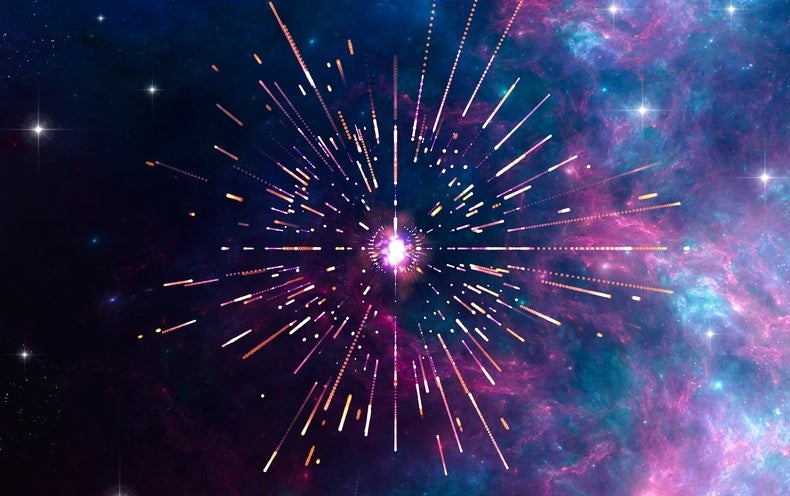
Of all the elementary particles in the universe, neutrinos may be the strangest. Sometimes known as “ghost particles,” these mysterious little packets of energy have no electrical charge, have almost no mass and come in at least three distinct varieties. New research is bringing science closer than ever to understanding the nature of neutrinos, from their size to their fundamental properties.
Neutrinos are mind-bogglingly tiny. With a mass of less than 0.8 electron volt each, they are “hundreds of thousands of times lighter than the next lightest particle, which is the electron,” says Kathrin Valerius, an astroparticle researcher at Germany’s Karlsruhe Institute of Technology.
They’re also ubiquitous. Tens of trillions of neutrinos pass through your body every second, originating mostly from the sun. But because of their small size and lack of charge, they rarely interact with your tissues—or anything else. “In your entire lifetime, if one neutrino interacts with you, then you’re lucky,” says experimental particle physicist Sowjanya Gollapinni of Los Alamos National Laboratory.
Theoretical physicists still know remarkably little about neutrinos, despite the fact that they have been aware of their existence for nearly a century. In 1930 renowned physicist Wolfgang Pauli was puzzling over a seemingly impossible conundrum. Over multiple experiments, Pauli’s contemporaries had noticed an accounting error when observing beta decay, a process by which certain radioactive atoms break down. Rather than being emitted as electrons, a small fraction of the decaying atom’s energy had apparently vanished.
This observation broke the the first law of thermodynamics, which states that energy cannot be created or destroyed. So Pauli proposed what he described as a “desperate remedy”: a new type of small, chargeless fundamental particle that was emitted alongside the electrons and accounted for the missing energy. The idea of the neutrino was born.
Pauli’s neutral particle was at last confirmed in 1956 in an experiment that proved its existence—but not its size. Theory predicted that neutrinos would be completely massless.
But in 2015 Takaaki Kajita of the University of Tokyo and Arthur McDonald of Queen’s University in Ontario won the Nobel Prize in Physics for research that proved the particles do actually have mass—though it did not reveal how much. In the mid-2000s the Mainz Neutrino Mass Experiment in Germany had set the upper limit of a neutrino’s mass at 2.3 electron volts. And in early 2022 data from the Karlsruhe Tritium Neutrino Experiment (KATRIN) in Germany .
Such a precise measurement requires very sensitive—and very large—equipment. KATRIN’s 200-metric-ton spectrometer and 70 meters of ultra-high-vacuum tubing are capable of reaching temperatures as low as -270.15 degrees Celsius and as high as 250 degrees C, allowing researchers to detect billions of particles. The extreme low temperatures keep highly heat-sensitive supermagnets cold enough to generate a strong magnetic field that allows detectors to catch individual particles. The experiment switches to high temperatures when it needs cleaning. Valerius, who works on the project, describes it as “a big pizza oven.”
Even this setup can’t detect the elusive ghost particles directly, however. Instead the spectrometer measures the energy of electrons that are released alongside neutrinos by radioactive hydrogen as it decays. The maximum energy of these electrons is well documented. Once the scientists record the total energy from this experiment, it is simply a matter of subtracting out the electron’s energy: whatever is left over belongs to the neutrinos.
Researchers are currently developing new experiments to further our understanding of neutrinos. One of them, dubbed the Deep Underground Neutrino Experiment, or DUNE, aims to understand another mysterious property of neutrinos: how they oscillate, or change type.
Neutrinos come in three “flavors”: electron, muon and tau. But these identities aren’t fixed. “If a neutrino is born as a certain flavor, as it travels, it can morph into other flavors,” explains Gollapinni, who is part of the DUNE collaboration. “It’s like changing your identity.” For example, some electron neutrinos from the sun turn into muon and tau neutrinos by the time they reach Earth. In order to understand why and how this change occurs, DUNE will observe a beam of neutrinos as it travels some 800 miles underground, from the experiment’s headquarters at Fermi National Accelerator Laboratory in Batavia, Ill., to the Sanford Underground Research Laboratory in South Dakota.
Researchers hope that experiments such as these will help to chip away at other major cosmological questions, such as the nature of dark matter (which might just be a fourth, not yet detected flavor of neutrino called a “sterile neutrino”), how black holes form or even the origin of matter itself. “The KATRIN collaboration has done a great job,” says Anthony Ezeribe, a particle physicist at the University of Sheffield in England, who is also part of DUNE, but “there is still work to be done.”
Valerius agrees. And like many neutrino scientists, she is excited by the vast research potential this tiny particle holds. “Our understanding, or lack of understanding, of the neutrino is not complete,” she says. “We don’t even know yet what we don’t know.”

